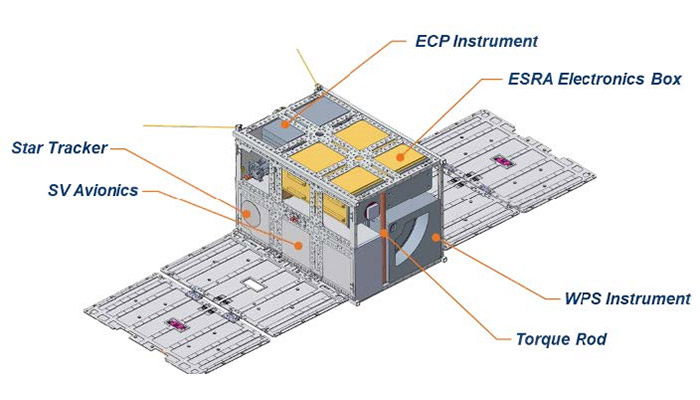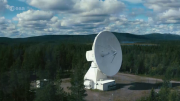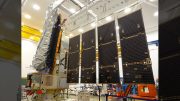LANL’s ESRA mission in GTO: first ever CubeSat to observe the energetic charged particles that populate the radiation belts
Los Alamos, New Mexico, USA, and Vilnius, Lithuania, 31 January 2024 – Smallsat mission integrator Kongsberg NanoAvionics US (“NanoAvionics”) has received a mission contract by Los Alamos National Laboratory (LANL), one of the largest science and technology institutions in the world.
The 12U (1U equals 10×10×10 cm3) spacecraft, about the size of a microwave oven, will host the Experiment for Space Radiation Analysis (ESRA) mission. ESRA is the latest of a series of demonstration and validation (Dem Val) missions built by the Los Alamos National Laboratory (LANL), with the focus of this mission on testing next generation charged particle sensors and critical flight subsystems.
ESRA will be inserted in geosynchronous transfer orbit (GTO) and make observations of the Earth’s dynamic radiation belts during the solar maximum. To date, no CubeSat has ever provided observations of the energetic charged particles that populate the radiation belts.
The ESRA mission will provide measurements of the charged particle populations using two science payloads and several subsystems: These are the wide-field-of-view plasma spectrometer (WPS) to measure ~100 eV to 35 keV ions, the energetic charged particle (ECP) telescope to measure 100 keV to 200 MeV ions along with 100 keV to 1 GeV electrons, a compact modular high voltage power supply (HVPS), payload flight processor (PFP), flight software architecture, and distributed processor module (DPM).
The LANL-designed payload processor will control the experiment, record the data, and communicate with the CubeSat avionics while the DPM will provide limited processing at the sensor head locations and packetize data thus enabling “smart sensors.”
Carlos Maldonado, ESRA principal investigator, said: “Partnering with the commercial sector, specifically NanoAvionics and KSAT, allows LANL technical staff to focus solely on the development of next generation technology and science payloads, while allowing industry partners to do what they do best. Leveraging commercial satellites and ground stations will allow LANL to rapidly mature technologies with reduced schedule, risk, and cost. The ESRA mission will demonstrate the capability of CubeSats for both science and space weather monitoring beyond low-Earth orbit and serve as a pathfinder for small satellites doing big science.”
To fit the ESRA payloads into the host spacecraft, NanoAvionics will configure one of its 12U modular buses by making some mechanical and components arrangements before assembling the nanosatellite. To operate the satellite while in orbit, ESRA will use NanoAvionics’ mission control software, capable of handling multiple satellite missions and compatible with all major commercial ground station providers with antennas in over 200 locations around the globe. For all other mission-related aspects, NanoAvionics will take an advisory role supporting the team at Los Alamos with launch vehicle integration and on-orbit operations.
Žilvinas Kvedaravičius, CEO of Kongsberg NanoAvionics, said: “We are thrilled to be working on our second mission with LANL following the 12U MAMBO satellite. This collaboration underscores the strength of our partnership and NanoAvionics’ commitment to advancing space exploration through its smallsat technology. The ESRA mission represents a pioneering venture into uncharted territory, and it marks the maiden flight of our built satellite in GTO, which fills the entire team with pride for their contribution to this project.”
Los Alamos National Laboratory, a multidisciplinary research institution engaged in strategic science on behalf of national security, is managed by Triad, a public service oriented, national security science organization equally owned by its three founding members: Battelle Memorial Institute (Battelle), the Texas A&M University System (TAMUS), and the Regents of the University of California (UC) for the Department of Energy’s National Nuclear Security Administration.
Los Alamos enhances national security by ensuring the safety and reliability of the U.S. nuclear stockpile, developing technologies to reduce threats from weapons of mass destruction, and solving problems related to energy, environment, infrastructure, health, and global security concerns.
Los Alamos National Laboratory orders second satellite from NanoAvionics













Be the first to comment on "Los Alamos National Laboratory orders second satellite from NanoAvionics"